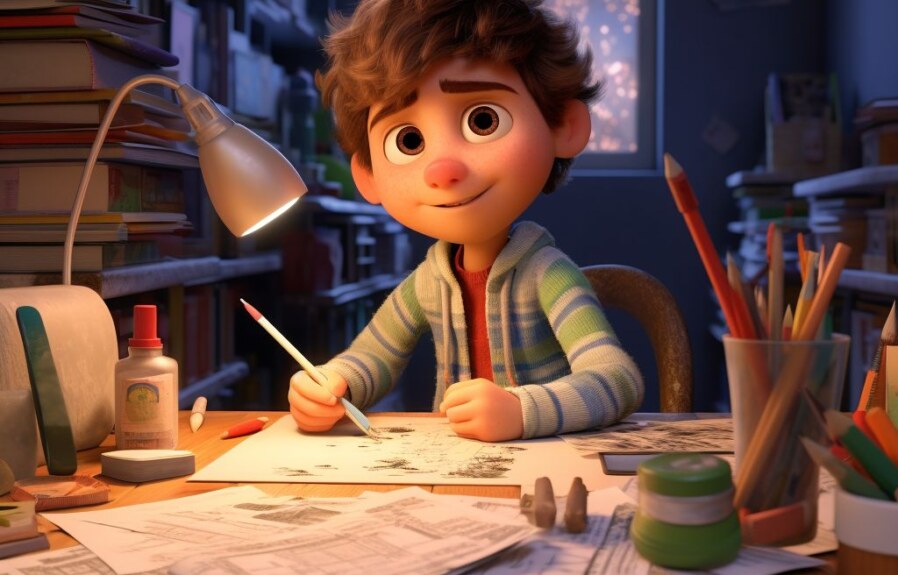Have you ever wanted to transfer a design from one surface to another with ease and accuracy? Cue tracing paper. Tracing paper has been a staple tool for artists, architects, and crafters for centuries. It’s a thin, translucent paper that allows you to see through it, making it the perfect medium for creating precise sketches, overlays, and illustrations. In this article, we’ll teach you how to use tracing paper and explore a few creative applications of this versatile tool.
1. Understanding the Basics of Tracing Paper: How does it work?
Tracing paper is a thin, translucent paper that is commonly used for a variety of purposes, including tracing and transferring images, designs, and patterns onto other surfaces. In this article, we will dive deeper into the basics of tracing paper, including how it works and its features.
Tracing paper is typically made from a variety of materials, including cellulose or polyester fibers, and has a coating that makes it translucent. The coating is usually made from wax or oil, and it is responsible for the paper’s ability to accept ink, lead, or other drawing materials.
Here are some key features that make tracing paper unique:
– Translucency: Tracing paper is translucent, which means that it allows light to pass through it. This feature allows artists and designers to trace existing images or create new ones by placing the paper over the desired surface and tracing the lines or shapes they see.
– Thinness: Tracing paper is thin and lightweight, which makes it ideal for tracing and transferring images without damaging the original surface or the paper itself.
– Versatility: Tracing paper can be used with a variety of drawing materials, including ink, lead, charcoal, and colored pencils. This versatility makes it a popular choice among artists, architects, and designers.
To summarize, tracing paper is a thin, translucent paper that has a coating that allows it to accept ink or lead. Its unique features include its translucency, thinness, and versatility.
2. Step-by-Step Guide: Using Tracing Paper for Sketching and Drawing
Using tracing paper is an excellent tool for creating sketches and drawings. In this step-by-step guide, we will show you how to use tracing paper to create your masterpiece.
1. Gather your supplies
To use tracing paper for sketching, you will need a few items. These include a sketchbook, a pencil, tracing paper, and an eraser. Make sure your pencil has a sharp tip, and the eraser is in good condition.
2. Choose an image
Select an image you want to trace. It can be any photo or printout of an illustration or drawing. Place the tracing paper on top of the image, so it lines up perfectly, and tape the edges of the paper to secure them in place.
3. Trace the image
Using your pencil, trace over the image’s outlines, making sure to capture all the details. Press firmly enough that the tracing paper will capture your lines. Be careful, because once you trace over an area, you cannot erase it on the tracing paper.
4. Transfer the image
Once you finish tracing, carefully remove the tape and tracing paper from the image underneath. Flip the tracing paper over and position it on a new sheet of paper or your sketchbook, tape down the edges, and trace over your original pencil lines lightly. This process will transfer the image to your new paper.
5. Finally, use your pencils or paints to shade in the traced drawing to create a finished piece of art. Using tracing paper is an excellent way to practice sketching and drawing while also preserving the original image. It’s a helpful technique for artists of all skill levels!
3. Tips and Tricks for Using Tracing Paper with Different Mediums
Tracing paper is a versatile tool that has a multitude of creative applications. However, using tracing paper with different mediums can be a bit tricky, especially if you’re not familiar with the process. To help you out, we’ve compiled a list of tips and tricks that will help you get the most out of tracing paper, no matter what medium you’re working with.
1. Use a hard pencil: When using tracing paper, it’s essential to use a hard pencil, like an H or 2H. This will help prevent smudging or smearing of your artwork.
2. Use a lightbox or window: If you’re having trouble seeing your original artwork through the tracing paper, try using a lightbox or placing your artwork in front of a window. This will help illuminate your original artwork, making it easier to trace.
3. Experiment with different mediums: Tracing paper can be used with a variety of mediums, including pencils, markers, and ink. Experiment with different mediums to see what works best for you.
4. Practice, practice, practice: Tracing paper takes some getting used to, so don’t be afraid to practice. The more you use it, the more comfortable you’ll become, and the better your results will be.
Overall, tracing paper is a valuable tool for artists, designers, and anyone looking to create precise, detailed artwork. With these tips and tricks, you’ll be able to use tracing paper with confidence, no matter what medium you’re working with.
4. Making the Most of Your Tracing Paper: Creative Applications and Techniques
When it comes to tracing paper, many people assume that it’s only good for tracing and outlines. However, this versatile material has a variety of creative applications and techniques beyond its basic purpose. Here are a few ideas to help you make the most out of your tracing paper and elevate your creative projects.
1. Layering: Tracing paper is translucent, making it perfect for layering. Try overlapping multiple sheets to create unique visual textures and effects. You can also layer your tracing paper over printed or painted designs to add depth and dimension to your work.
2. Collage: Cut out shapes or designs from your tracing paper and use them to create unique collages. The lightweight nature of the paper makes it easy to arrange the pieces in interesting compositions, and the transparency adds a dreamy or whimsical effect to your finished project.
3. Embellishment: Tracing paper can be further decorated or embellished in many ways. Experiment with adding watercolor or acrylic paint, markers or colored pencils to your tracing paper. You can also try embossing or adding foil to your designs to create unique textures and effects.
4. Solar Printing: Place an object on your tracing paper and expose it to direct sunlight to create a solar print. The portion of the paper exposed to the sun will darken, while the areas covered will remain lighter, creating an interesting and unique print perfect for use in art and craft projects.
The possibilities with tracing paper are endless. Experiment with different techniques and let your creativity soar. Whether you’re using it for design work or for imaginative projects, tracing paper is a material worth exploring.
5. Avoiding Common Mistakes When Using Tracing Paper
Tracing paper can be a handy tool in various situations. It makes tracing designs and fine details easy. However, there are some common pitfalls to watch out for when using tracing paper. Here are some tips to avoid these mistakes:
– Use a sharp pencil: A dull pencil can tear the tracing paper or smudge the lines. Keep the pencil sharp, and use light pressure when tracing.
– Use the right side of the paper: Most tracing paper has a rough side and a smooth side. The rough side is meant to be the drawing surface, while the smooth side is meant to receive the transfer. Make sure to use the correct side for the desired effect.
– Protect the paper: Tracing paper is thin and delicate, so it’s important to protect it from damage. Place a scrap piece of paper under the tracing paper to prevent it from tearing, and use a binder clip or masking tape to hold it in place.
– Avoid erasing: Tracing paper is designed to be a transfer medium, not a permanent drawing surface. If you make a mistake, try to work around it rather than erasing it. Erasing can smudge the transfer and damage the paper.
– Don’t press too hard: Tracing paper is delicate and can tear easily. Use light pressure when tracing to avoid tearing or creating visible holes in the paper.
Following these tips can help you successfully use tracing paper without any common mistakes. Happy tracing!
6. Efficient and Eco-Friendly: How to Reuse Tracing Paper
Tracing paper is a popular drawing tool that is mainly used by architects, engineers, and artists. However, it can be easy to use a lot of this paper and toss it out after every use. Fortunately, there are many ways you can reuse tracing paper to save money and help the environment. Below are some efficient and eco-friendly ways to repurpose tracing paper.
1. Use it as a protective layer
Tracing paper can be used as a protective layer for items that need to be transported or shipped. Simply cover the surface of the item with the tracing paper, and then wrap it in another protective layer. This method ensures that your items are protected from scratches, dust, and moisture.
2. Use it for sketching
Tracing paper can also be used for sketching. Place the tracing paper on top of your reference image, and then draw your sketch on top of it. This technique is useful for creating rough sketches that can be quickly redone until you get the result you want.
3. Use it for scrapbooking
Tracing paper can add texture and variation to scrapbooking projects. Simply trace your chosen image or text onto the tracing paper and then cut it out. You can layer it on top of other papers or use it as a background layer.
In summary, there are many ways that you can reuse tracing paper to save money and help the environment. Whether you choose to use it as a protective layer, for sketching, or for scrapbooking, tracing paper is a versatile and eco-friendly option for your creative needs.
7. Experimenting with Tracing Paper: Exploring Its Versatility and Potential
Tracing paper is a versatile and popular medium that artists and designers have been using for decades. It is a thin, translucent paper that can be used for a wide range of purposes, from sketching and tracing to creating overlays and stencils. In this post section, we will explore the versatility and potential of tracing paper and how it can be used to create unique and creative artworks and designs.
Here are some ways you can experiment with tracing paper:
1. Layering: Tracing paper can be used to create layered effects in your artwork. You can draw different elements on separate sheets of tracing paper and layer them on top of each other to create a complex and intricate image.
2. Transfer: Tracing paper is an excellent tool for transferring your designs onto other surfaces. You can place your tracing paper over a surface and trace your design onto it, creating a template that you can use for painting, embroidery, or any other craft.
3. Texture: Tracing paper can be used to create interesting textures in your artwork. You can crumple or fold the tracing paper before drawing on it to create a rough, textured surface that adds depth and dimension to your artwork.
4. Mix Media: Tracing paper can be combined with other mediums to create unique and creative effects. You can use markers, colored pencils or even watercolors to fill in your traced designs, creating a bold and colorful artwork.
By experimenting with tracing paper, you can discover new techniques, styles, and applications that you may never have considered before. Whether you are an artist, designer or crafter, tracing paper is a versatile medium that is worth exploring.
People Also Ask:
What is tracing paper used for?
Tracing paper is used to transfer images or designs from one surface to another. It is a thin, translucent paper that allows you to see through it, making it easy to trace an image or design.
How do you use tracing paper for drawings?
To use tracing paper for drawings, simply place the tracing paper over the initial sketch, and then trace over it with a pencil, pen or marker. The traced design will then appear on the tracing paper, allowing you to refine your sketch or keep the design for reference.
Can you print on tracing paper?
Yes, you can print on tracing paper using a printer that is designed to handle thin paper types. To avoid smudging, it is best to wait for the ink to dry before handling the paper.
How do you transfer a design to fabric using tracing paper?
To transfer a design to fabric using tracing paper, simply trace the design onto the tracing paper, place the paper on the fabric with the traced side facing down, and then use a hot iron to transfer the design onto the fabric.
What kind of pencils should I use with tracing paper?
When using tracing paper, it is best to use a hard pencil, such as an H or 2H pencil. Soft pencils, such as 2B or 4B, can smudge and make it difficult to trace the design accurately.
Conclusion
Tracing paper is a versatile tool that can be used for a variety of purposes, from drawing and sketching to transferring designs onto fabric or other surfaces. By understanding how to use tracing paper and the best practices for doing so, you can improve your drawing skills, create precise designs, and have a lot of fun in the process.



